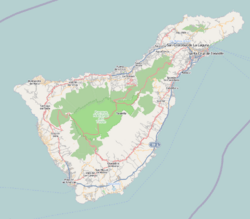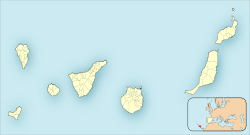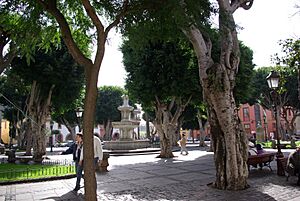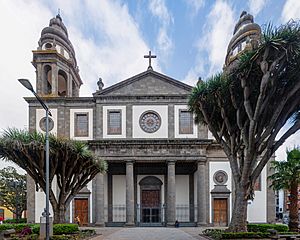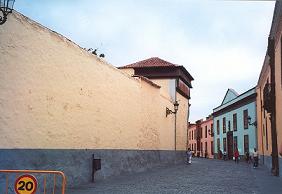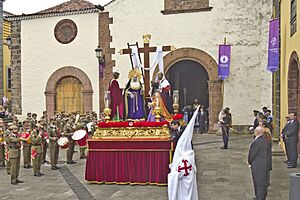San Cristóbal de La Laguna facts for kids
Quick facts for kids
San Cristóbal de La Laguna
|
|||
|---|---|---|---|
|
Municipality and city
|
|||
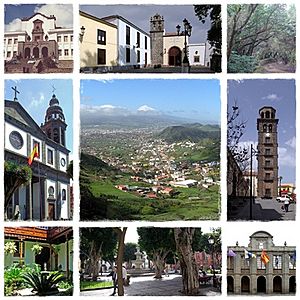
Clockwise from top: University of La Laguna, Shrine of Cristo de La Laguna, Forests, Cathedral of La Laguna, Panoramic city, Iglesia de la Concepción, Consejo Consultivo de Canarias, Plaza del Adelantado and city council.
|
|||
|
|||
| Nickname(s):
"La Ciudad de los Adelantados", "La Ciudad de Aguere".
|
|||
| Country | Spain | ||
| Autonomous community | Canary Islands | ||
| Province | Santa Cruz de Tenerife | ||
| Area | |||
| • Total | 102.6 km2 (39.6 sq mi) | ||
| Elevation | 543 m (1,781 ft) | ||
| Population
(2018)
|
|||
| • Total | 155,549 | ||
| • Density | 1,516.1/km2 (3,926.6/sq mi) | ||
| Time zone | UTC0 (WET) | ||
| • Summer (DST) | UTC+1 (WEST) | ||
| Postal code |
38200
|
||
| Official language(s) | Spanish | ||
| UNESCO World Heritage Site | |||
| Criteria | Cultural: (ii), (iv) | ||
| Inscription | 1999 (23rd Session) | ||
| Area | 60.38 ha (149.2 acres) | ||
| Buffer zone | 23.71 ha (58.6 acres) | ||
San Cristóbal de La Laguna, often called La Laguna, is a city and a municipality. It is located in the northern part of Tenerife, which is one of the Canary Islands in Spain. This city was once the capital of the Canary Islands.
Today, La Laguna is the third-largest city in the Canary Islands by population. It is also the second-largest city on Tenerife island. In 1999, its historic center became a World Heritage Site by UNESCO.
La Laguna is right next to Santa Cruz de Tenerife. These two cities form one big urban area. La Laguna is known as the cultural capital of the Canary Islands. It is home to the Cathedral of La Laguna, which is the main Catholic church for Tenerife.
Famous people from La Laguna include Amaro Pargo, a well-known privateer (like a legal pirate) from the 17th and 18th centuries. Another important figure is José de Anchieta, a Catholic saint who helped found cities in Brazil.
Contents
- What Does "La Laguna" Mean?
- What is the City's Coat of Arms?
- What are the Main Areas of La Laguna?
- What is the Climate Like in La Laguna?
- A Brief History of La Laguna
- What Can You See in La Laguna?
- What are the Main Festivals and Holidays?
- Which Cities are Sister Cities with La Laguna?
- Who are Some Famous People from La Laguna?
- See also
What Does "La Laguna" Mean?
Alonso Fernández de Lugo founded the city and first named it "Villa de San Cristóbal de La Gran Laguna". This name likely came from a nearby pond or lake, as laguna means lake in Spanish. Over time, the name was shortened to "San Cristóbal de La Laguna".
What is the City's Coat of Arms?
The city's coat of arms was given by Queen Joanna of Castile in 1510. It was originally for the island of Tenerife. Since La Laguna was the capital, the city adopted it as its own symbol.
The coat of arms shows an island with a volcano erupting, surrounded by waves. There is also a castle and a lion. Above these, you can see the archangel Saint Michael. He holds a spear and a shield. The words around the edge mean "Archangel Michael, come to the aid of the people of God. Tenerife made me." These symbols represent Tenerife joining the Crown of Castile and its Christian faith under Saint Michael.
What are the Main Areas of La Laguna?
La Laguna is divided into several smaller areas. Some of these include:
- La Verdellada
- Viña Nava
- El Coromoto
- San Benito
- El Bronco
- La Cuesta
- Taco
- Tejina
- Valleguerra
- Bajamar
- Punta del Hidalgo
- Geneto
- Los Baldios
- Guamasa
- El Ortigal
- Las Mercedes
- El Batan
- Las Carboneras
- San Diego
- Las Gavias
What is the Climate Like in La Laguna?
La Laguna has a Mediterranean climate. This is different from other cities in the Canary Islands, which are often very dry. La Laguna gets more rain because it catches moisture from the winds.
It receives three to five times more rainfall than the southern parts of the island. It also has less sunshine and higher humidity throughout the year. Even though it's high up, the ocean and subtropical weather keep it from getting too cold. It almost never freezes.
A Brief History of La Laguna
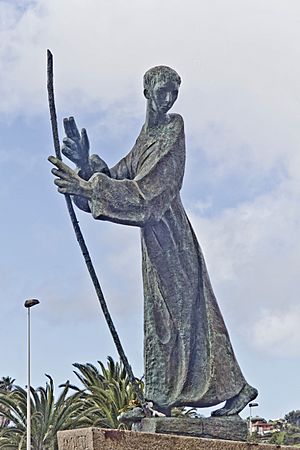
The area where La Laguna stands was once part of the Menceyato de Anaga. This was one of nine kingdoms of the native Guanches people. The valley of Aguere, where the city is, used to have a large lake. This lake was a special place for the native people.
The city was founded between 1496 and 1497 by Alonso Fernández de Lugo. It became the capital of Tenerife after the island was conquered. Later, it even became the capital for all of the Canary Islands. In 1582, a terrible plague hit the city, causing many deaths.
The way La Laguna was planned became a model for many Spanish colonial cities in the Americas. The University of La Laguna was founded in 1701.
In the 1700s, La Laguna's population and economy declined. Because of this, the capital was moved to Santa Cruz de Tenerife in 1723. Santa Cruz remained the sole capital of the Canary Islands until 1927. Now, the capital is shared with Las Palmas de Gran Canaria.
The Tenerife North Airport opened in the 1930s and is still growing today.
The historic center of La Laguna was named a World Heritage Site in 1999. Many historic streets are now closed to cars. La Laguna is sometimes called the "Florence of the Canary Islands." This is because of its many churches, convents, and old buildings. It was also a center for art and culture, especially during the Baroque period (17th-18th centuries).
Recently, tunnels and underground spaces have been found beneath old buildings. These include the Iglesia de la Concepción and the Cathedral of La Laguna. Researchers believe the city's ground level has risen over time, burying these older structures.
What Can You See in La Laguna?
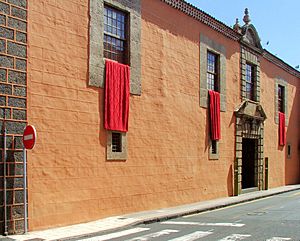
La Laguna has many interesting places to visit:
- Cathedral of La Laguna: This church has a beautiful neoclassical front built in 1819.
- Iglesia de la Concepción: This was the very first church built on Tenerife island.
- Old City: This area is a UNESCO World Heritage Site. Its street layout inspired many cities in Latin America. You can see many old colonial-style buildings with wooden balconies and lovely courtyards filled with trees and flowers.
- Real Santuario del Santísimo Cristo de La Laguna: This is a very important church. Inside, there is a much-loved image of Christ, popular throughout the Canary Islands.
- University of La Laguna: This was the first university to be founded in the Canary Islands.
- Casa Anchieta: This is the birthplace of Saint José de Anchieta. He is known as the "Apostle of Brazil" by the Catholic Church.
- Salazar Palace: This grand palace is now the bishop's palace for the Diocese of Tenerife. It has a special chapel with a beautiful mosaic.
- Nava Palace: This building shows a mix of different architectural styles, including Baroque and Neoclassical.
- Church of Santo Domingo de Guzmán: This is one of the city's oldest churches. The famous privateer Amaro Pargo is buried here.
- Instituto Canarias Cabrera Pinto: This is the oldest high school in the Canary Islands that is still in use.
- Teatro Leal: A historic theater built in 1915.
- Plaza del Adelantado: This is the city's main square. It is surrounded by important buildings like the town hall and the Santa Catalina de Siena convent.
- Museum of the History of Tenerife: This museum (located in Palacio Lercaro) tells the story of Tenerife from the 15th century to today. It is also known for stories about the ghost of Catalina Lercaro, a young woman from the 16th century.
What are the Main Festivals and Holidays?
- Romería Regional de San Benito Abad: This is a very popular procession (romeria) and is considered the most important in the Canary Islands. Groups from all over the islands come to celebrate on the second Sunday of July. People dress in traditional costumes and pull decorated carts with farm animals. There is also Canarian folk music.
- Holiday of the Cristo de La Laguna: Celebrated every September 14th. This holiday honors a very special image of Christ, the Cristo de La Laguna. People from all over the islands come for this event. It is the biggest holiday in the city.
- Holy Week: This is the largest Holy Week celebration in the Canary Islands. During this week, many historic and artistic statues are carried through the streets. These processions are organized by guilds, some of which are hundreds of years old.
Which Cities are Sister Cities with La Laguna?
La Laguna has special connections with other cities around the world. These "sister cities" include:
 Cartagena de Indias, Colombia
Cartagena de Indias, Colombia São Paulo, Brazil
São Paulo, Brazil Telde, Spain
Telde, Spain Colima, Mexico
Colima, Mexico
Who are Some Famous People from La Laguna?
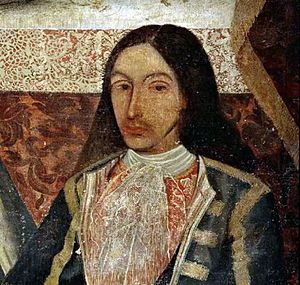
Many notable people were born in or lived in La Laguna:
- José de Anchieta (1534–1597): A saint important in the early history of Brazil.
- Amaro Pargo (1678–1747): A Spanish privateer and merchant.
- José Rodríguez de la Oliva (1695–1777): A sculptor and painter from the Baroque period.
- Oscar Domínguez (1906–1957): A Spanish surrealist painter.
- Suso Santana (born 1985): A footballer.
- Sergio Rodriguez (born 1986): A basketball player.
- Ana Guerra (born 1994): A singer who became famous on the TV show Operación Triunfo 2017.
See also
 In Spanish: San Cristóbal de La Laguna para niños
In Spanish: San Cristóbal de La Laguna para niños




